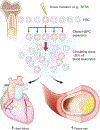Myeloid cell contributions to cardiovascular health and disease
- PMID: 29867229
- PMCID: PMC7301893
- DOI: 10.1038/s41591-018-0064-0
Myeloid cell contributions to cardiovascular health and disease
Abstract
Recent advances in cell tracing and sequencing technologies have expanded our knowledge on leukocyte behavior. As a consequence, inflammatory cells, such as monocyte-derived macrophages, and their actions and products are increasingly being considered as potential drug targets for treatment of atherosclerosis, myocardial infarction and heart failure. Particularly promising developments are the identification of harmful arterial and cardiac macrophage subsets, the cells' altered, sometimes even clonal production in hematopoietic organs, and epigenetically entrained memories of myeloid progenitors and macrophages in the setting of cardiovascular disease. Given the roles of monocytes and macrophages in host defense, intricately understanding the involved cellular subsets, sources and functions is essential for the design of precision therapeutics that preserve protective innate immunity. Here I review how new clinical and preclinical data, often linking the cardiovascular, immune and other organ systems, propel conceptual advances to a point where cardiovascular immunotherapy appears within reach.
Figures



References
-
- Ridker PM et al. Antiinflammatory Therapy with Canakinumab for Atherosclerotic Disease. N Engl J Med 377, 1119–1131 (2017). - PubMed
Publication types
MeSH terms
Grants and funding
LinkOut - more resources
Full Text Sources
Other Literature Sources
Research Materials

